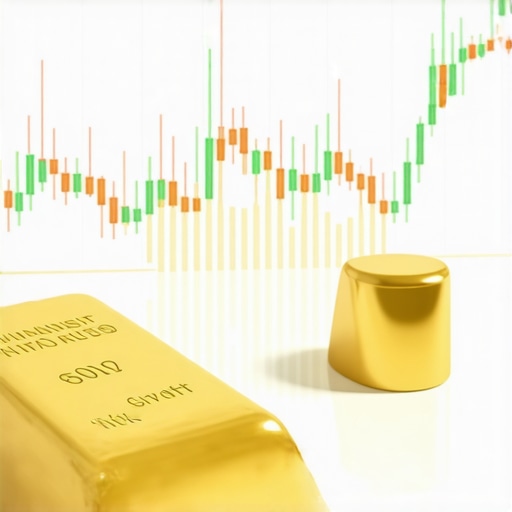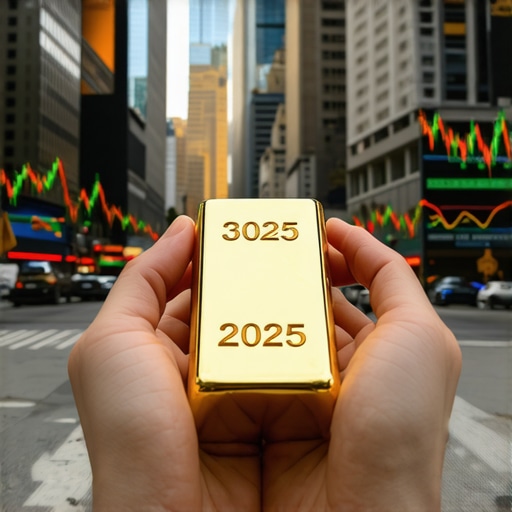Unlocking the Golden Path: Why Smart Gold Investment Matters Today
In an era marked by economic uncertainties and market volatility, gold remains a timeless beacon of financial security and wealth preservation. For discerning investors aiming to build long-term wealth, understanding smart gold investment strategies is not just advisable—it’s essential. This precious metal transcends fleeting market trends, offering a robust hedge against inflation, currency devaluation, and geopolitical risks. However, mastering the nuances of gold investment demands insight beyond simply buying bullion or coins. It requires a strategic approach that blends diversification, timing, and asset selection to capitalize on gold’s unique benefits.
Beyond the Bar: Innovative Approaches to Diversifying with Gold
While physical gold like coins and bars has long been the cornerstone of gold investing, modern portfolios benefit from integrating various gold-related assets. These include gold ETFs, mining stocks, and futures contracts, each offering distinct risk-return profiles and liquidity advantages. For example, gold mining stocks can provide leveraged exposure to gold prices, often outperforming bullion during upward trends, but they carry operational risks tied to mining activities. Alternatively, gold ETFs offer a liquid, cost-efficient way to gain exposure without the hassles of storage and authentication.
To navigate these options effectively, investors should consider combining physical gold holdings with carefully selected ETFs or stocks, thereby balancing tangible security with market agility. This blend can optimize portfolio resilience, especially during inflationary cycles or financial downturns.
Strategic Timing: Capitalizing on Gold Market Cycles and Demand Trends
Gold prices are influenced by complex global demand-supply dynamics, including central bank purchases, jewelry demand, and industrial usage. Monitoring these trends empowers investors to time their entries and exits more judiciously. For instance, recent analyses highlight how central banks’ increased gold reserves signal confidence in gold’s long-term value, often preceding price appreciation phases. Additionally, geopolitical tensions typically trigger spikes in gold demand as a safe haven asset.
Experienced investors track these indicators alongside technical analysis to identify opportune moments to accumulate or divest. Incorporating insights from resources like understanding global gold demand trends and their price effects can enrich decision-making with data-driven perspectives.
How Can Investors Balance Physical Gold and Financial Gold Instruments for Optimal Growth?
Balancing physical gold and financial instruments such as ETFs or futures is a nuanced endeavor. Physical gold offers unmatched security and inflation protection but poses challenges like storage costs and liquidity constraints. Financial instruments, conversely, provide ease of trading and diversification but may expose investors to counterparty risks and market volatility.
Prudent investors often allocate a core portion of their portfolio to physical gold to anchor their wealth, while deploying a tactical allocation to ETFs and mining stocks to capture growth and income opportunities. This strategy harnesses the stability of tangible assets with the flexibility of market instruments, fostering comprehensive wealth-building potential.
Embedding Expertise: Practical Wisdom for Long-Term Gold Wealth Accumulation
Drawing from decades of market observation, seasoned investors emphasize the importance of patience and disciplined accumulation. Dollar-cost averaging into gold positions over time mitigates the impact of price fluctuations, enabling investors to build wealth steadily without succumbing to market timing pitfalls. Moreover, understanding the authenticity and provenance of physical gold is critical—counterfeiting risks necessitate purchasing from reputable sources and verifying certifications.
For those beginning their gold investment journey, consulting guides such as investing in gold for beginners: how to start with confidence can provide foundational knowledge and actionable steps.
Engage with Us: If you have experiences or questions about integrating gold into your wealth strategy, share your thoughts below or explore more expert insights on smart gold investment strategies to diversify with stocks and bars at this comprehensive resource.
Authoritative Source: For a rigorous economic perspective on gold’s role in portfolios, consider the insights from the World Gold Council’s research on gold as a strategic asset (gold.org), which underscores gold’s enduring value as a diversifier and inflation hedge.
Leveraging Gold Futures and Options: Advanced Tools for Portfolio Enhancement
For investors seeking to amplify their exposure to gold’s price movements while controlling risk, gold futures and options offer sophisticated avenues. Futures contracts allow investors to buy or sell gold at a predetermined price on a future date, enabling strategic positioning ahead of anticipated market shifts. Options provide the right, but not the obligation, to execute such trades, introducing flexibility that can protect portfolios during volatility.
Utilizing these derivatives demands a thorough grasp of market mechanics and risk management. Experienced traders often combine futures and options to hedge existing physical holdings or speculate on short-term price trends, enhancing returns without overexposing their capital. Resources like gold futures trading tips can provide invaluable guidance for mastering these instruments.
Understanding Central Banks’ Gold Movements: A Key to Predicting Market Shifts
Central banks play a pivotal role in shaping gold demand and price trajectories. Their strategic acquisitions or sales often signal macroeconomic confidence or concerns, influencing investor sentiment globally. Monitoring central bank gold purchases helps investors anticipate potential market rallies or downturns, especially when aligned with geopolitical developments.
Research from the World Gold Council highlights that recent upticks in central bank buying reflect a diversification away from fiat currencies, reinforcing gold’s status as a stable reserve asset. Staying informed on these trends through analysis like how central bank gold trends influence global price movements equips investors with foresight essential for timing their investments effectively.
What Are the Risks and Rewards of Integrating Gold Mining Stocks into a Diversified Portfolio?
Gold mining stocks offer the potential for leveraged gains compared to physical gold, as mining company profits can multiply when gold prices rise. However, these stocks also carry unique risks such as operational challenges, regulatory changes, and commodity price volatility. Investors must weigh these factors carefully.
Incorporating mining stocks can enhance portfolio growth but demands rigorous analysis of company fundamentals and geopolitical risk exposure. Diversifying across multiple mining stocks and balancing with physical gold or ETFs can mitigate individual stock risks while capitalizing on gold’s price appreciation. For practical strategies, explore top gold mining stocks to watch and their growth prospects.
Engage With Fellow Investors: What has been your experience with balancing physical gold and mining stocks? Share your insights or questions below to contribute to a nuanced discussion on effective gold investment strategies.
Mastering Gold Derivatives: Navigating Futures and Options for Enhanced Portfolio Control
Delving deeper into gold derivatives, futures and options are not mere tools for speculation but powerful instruments for sophisticated portfolio management. Gold futures contracts obligate the buyer or seller to transact at a predetermined price on a specified future date, enabling strategic positioning to hedge against adverse price movements or to capitalize on anticipated trends. Meanwhile, gold options confer the right, without obligation, to buy (call) or sell (put) gold at a set price, adding a layer of flexibility that can mitigate downside risk while preserving upside potential.
Expert investors often apply complex strategies such as spread trading—simultaneously buying and selling options or futures across different maturities or strike prices—to exploit volatility or temporal price differentials. For instance, a calendar spread can capture gains from expected shifts in gold’s price curve, while protective puts can safeguard physical holdings during market downturns. However, mastery of these tactics requires rigorous understanding of implied volatility, time decay, and margin requirements, elements that seasoned traders monitor vigilantly.
For those keen to elevate their trading acumen, resources like gold futures trading tips offer in-depth strategic frameworks to navigate complex derivatives markets effectively.
Decoding Central Bank Gold Movements: Strategic Signals in Global Economic Chess
Central banks’ gold transactions are often the harbingers of macroeconomic shifts. Their strategic accumulation or divestment reflects broader monetary policy maneuvers, currency reserve diversification, and geopolitical risk assessments. An uptick in central bank gold purchases frequently signals a recalibration away from fiat currencies towards tangible assets, underpinning gold’s role as a safe haven and inflation hedge.
Moreover, these movements shape global liquidity and influence gold’s supply-demand equilibrium. For example, coordinated purchasing by multiple central banks can tighten the physical gold market, driving prices upward, while significant sales may exert downward pressure. Investors who monitor these trends alongside geopolitical developments, interest rate policies, and currency fluctuations can anticipate market inflection points with greater precision.
The World Gold Council’s detailed analyses (gold.org research on central bank reserves) provide authoritative data and interpretations essential for decoding these complex dynamics.
How Do Central Bank Gold Reserves Influence Investor Behavior and Market Volatility?
Central bank gold reserves act as a stabilizing force in financial markets, often dampening volatility by signaling confidence in gold’s long-term value. When central banks increase reserves, it reassures investors of gold’s enduring status, potentially attracting increased private investment and amplifying price momentum. Conversely, unexpected central bank sales can trigger market uncertainty, provoking short-term volatility.
Understanding this interplay requires investors to integrate macroeconomic indicators, geopolitical risk assessments, and central bank communications into their analysis. This multidimensional perspective empowers investors to align their gold portfolio strategies with prevailing market sentiments and systemic risk cycles.
Integrating Gold Mining Stocks with Physical and Derivative Assets: A Holistic Wealth-Building Framework
While physical gold and derivatives provide foundational and tactical roles respectively, gold mining stocks introduce an equity dimension that can amplify portfolio returns through operational leverage to gold prices. However, mining equities are sensitive not only to gold price fluctuations but also to company-specific factors such as production costs, geopolitical risks, and management efficacy.
Advanced investors adopt a holistic framework that synergizes physical holdings for stability, derivatives for risk management and tactical positioning, and mining stocks for growth potential. This triad approach necessitates continuous monitoring of mining sector fundamentals, geopolitical developments, and derivative market conditions to optimize asset allocation dynamically.
Exploring comprehensive market analyses like top gold mining stocks to watch can provide insights into companies best positioned to capitalize on anticipated gold market trajectories.
Practical Considerations for Institutional-Grade Gold Portfolio Management
Institutional investors managing large-scale gold portfolios confront unique challenges, including liquidity constraints, regulatory compliance, and counterparty risk. They often employ advanced custody solutions, including allocated and unallocated storage, alongside auditing protocols to ensure asset integrity. Furthermore, integrating algorithmic trading strategies with fundamental analysis allows for optimized execution in volatile markets.
Risk management frameworks incorporate scenario analysis, stress testing, and correlation studies between gold and other asset classes to maintain portfolio resilience. Leveraging insights from authoritative bodies such as the International Monetary Fund and the World Gold Council enables institutions to align their gold strategies with global economic trends and regulatory environments.
Engage with Our Expert Community: Whether you are refining a sophisticated gold derivatives strategy or evaluating the impact of central bank policies on your portfolio, share your questions and experiences below. Dive deeper into expert analyses and actionable strategies by exploring our advanced gold investment resources.
Harnessing Algorithmic Trading in Gold Markets: The Frontier of Automated Precision
With the increasing complexity and speed of global financial markets, algorithmic trading has emerged as a pivotal tool for institutional and sophisticated investors to optimize gold portfolio execution. By deploying quantitative models that integrate macroeconomic indicators, price momentum, and volatility measures, algorithmic strategies can dynamically adjust gold exposure, minimize slippage, and capitalize on transient arbitrage opportunities. This approach requires robust data infrastructure and continuous refinement to adapt to evolving market regimes, underscoring the necessity for expertise in both financial engineering and gold market fundamentals.
Deciphering Geopolitical Risk Premiums Embedded in Gold Pricing
Gold’s role as a geopolitical risk barometer is well-established; however, quantifying the embedded risk premiums within gold prices remains a sophisticated analytical challenge. Advanced investors employ econometric models that isolate geopolitical event impacts from other supply-demand factors, enabling more precise timing and sizing of gold allocations. For example, shifts in U.S.-China relations or Middle Eastern tensions often precipitate measurable gold price spikes, which can be anticipated through sentiment analysis and geopolitical risk indices. Integrating these insights with derivative hedging techniques enhances portfolio resilience against unforeseen shocks.
How Can Institutional Investors Integrate ESG Criteria into Gold Mining Stock Selections Without Compromising Returns?
Institutional investors increasingly prioritize Environmental, Social, and Governance (ESG) factors when selecting gold mining equities, balancing ethical considerations with financial performance. Incorporating ESG metrics involves rigorous due diligence on mining companies’ sustainability practices, community relations, and governance structures. While some perceive ESG integration as a potential constraint on returns, emerging research and case studies demonstrate that firms with robust ESG profiles often exhibit superior operational efficiency and lower regulatory risks, translating into long-term value creation. Utilizing ESG-focused indices and engaging actively with mining companies can further align investment objectives with sustainability goals.
For comprehensive ESG analysis frameworks and best practices in gold mining investments, the MSCI ESG Investing platform offers authoritative, data-driven methodologies widely adopted by institutional investors worldwide.
Advanced Tax Optimization Strategies for Gold Investment Portfolios
Tax implications can significantly affect net returns from gold investments, especially for high-net-worth individuals and institutional portfolios. Advanced strategies include utilizing tax-advantaged accounts, strategic timing of asset disposals to manage capital gains, and employing gold-backed Exchange-Traded Funds (ETFs) domiciled in tax-efficient jurisdictions. Additionally, investors may leverage loss harvesting techniques and derivative instruments to offset taxable gains, thereby enhancing after-tax performance. Navigating the complex and jurisdiction-specific tax regulations necessitates collaboration with specialized tax advisors well-versed in precious metals.
Leveraging Blockchain and Tokenization to Enhance Gold Liquidity and Transparency
The advent of blockchain technology has introduced innovative pathways to increase gold market accessibility and transparency through tokenization. Digital tokens backed by physical gold enable fractional ownership, 24/7 trading, and streamlined transferability, potentially reducing traditional barriers such as storage costs and illiquidity. Moreover, blockchain’s immutable ledger facilitates provenance verification, combating counterfeiting and enhancing investor confidence. While regulatory landscapes continue to evolve, early adopters of tokenized gold assets position themselves at the forefront of a transformative shift in precious metals trading.
Engage with Our Expert Community: Are you exploring algorithmic strategies, ESG integration, or blockchain innovations in your gold portfolio? Share your experiences and questions below to connect with fellow advanced investors and deepen your mastery of sophisticated gold investment methodologies.
Frequently Asked Questions (FAQ)
What are the main advantages of holding physical gold compared to gold ETFs or mining stocks?
Physical gold provides direct ownership of a tangible asset, offering unmatched security against inflation and currency devaluation. It is free from counterparty risk but involves considerations like storage, insurance, and liquidity constraints. Gold ETFs and mining stocks offer easier tradability and diversification but expose investors to market and operational risks respectively. Balancing these holdings can optimize portfolio resilience and growth.
How do central bank gold purchases impact gold market prices and investor strategies?
Central bank acquisitions signal confidence in gold’s long-term value, often tightening supply and catalyzing price appreciation. These movements influence investor sentiment by indicating shifts away from fiat currencies toward tangible reserves. Monitoring central bank trends helps investors anticipate market rallies or volatility and align their timing and asset allocation accordingly.
What role do gold futures and options play in managing investment risk?
Gold futures obligate buying or selling gold at a fixed future price, enabling hedging or speculative positioning. Options grant the right, without obligation, to transact at set prices, providing flexibility to limit downside risk while preserving upside potential. Together, they allow sophisticated risk management strategies but require deep market knowledge to navigate margin requirements, volatility, and time decay.
Can integrating gold mining stocks enhance portfolio returns despite their risks?
Yes, mining stocks offer leveraged exposure to gold price movements, potentially amplifying returns. However, they carry risks such as operational issues, geopolitical uncertainties, and regulatory changes. Careful fundamental analysis and diversification within mining equities can mitigate risks while capturing growth opportunities complementary to physical gold and derivatives.
How can algorithmic trading improve gold investment outcomes?
Algorithmic trading leverages quantitative models to execute trades based on macroeconomic indicators, price momentum, and volatility patterns. This approach reduces human bias, optimizes trade timing, minimizes slippage, and exploits transient arbitrage opportunities. It requires advanced data infrastructure and continuous model refinement to adapt to evolving gold market conditions.
What considerations should institutional investors keep in mind when managing large gold portfolios?
Institutions must address liquidity management, regulatory compliance, counterparty risk, and asset custody solutions. Employing advanced risk management frameworks including scenario analysis and stress testing ensures portfolio robustness. Integration of algorithmic trading and active monitoring of global economic trends further enhances strategic decision-making.
How does ESG integration affect gold mining stock selection and returns?
Incorporating Environmental, Social, and Governance criteria promotes sustainable investing by evaluating mining companies’ ethical practices and governance. Contrary to concerns, companies with strong ESG profiles often demonstrate better operational efficiency and risk management, potentially enhancing long-term returns. Utilizing ESG indices and engaging with companies supports alignment of financial goals with sustainability.
What tax optimization strategies can enhance after-tax returns on gold investments?
Advanced strategies include holding gold in tax-advantaged accounts, timing disposals to manage capital gains, using tax-efficient gold ETFs, and employing loss harvesting. Collaboration with specialized tax advisors is crucial due to the complexity and jurisdiction-specific nature of tax regulations affecting precious metals.
How does blockchain technology and tokenization transform gold investing?
Blockchain enables fractional ownership of gold through tokenization, increasing liquidity, transparency, and 24/7 tradability. It enhances provenance verification and reduces counterfeiting risks via immutable ledgers. While regulatory frameworks are evolving, tokenized gold assets represent a cutting-edge innovation expanding market accessibility.
What is the significance of geopolitical risk premiums in gold pricing?
Geopolitical tensions embed risk premiums into gold prices, often triggering sharp price spikes as investors seek safe havens. Advanced modeling isolates these effects from supply-demand factors, allowing more precise portfolio adjustments. Integrating geopolitical sentiment analysis with derivative hedging can fortify portfolios against unforeseen shocks.
Trusted External Sources
- World Gold Council (gold.org): Offers comprehensive research on gold’s role as a strategic asset, central bank reserves data, and market analysis critical for understanding gold’s macroeconomic significance.
- MSCI ESG Investing Platform (msci.com): Provides authoritative ESG metrics and frameworks widely used by institutional investors for sustainable gold mining stock selection and analysis.
- International Monetary Fund (IMF): Delivers global economic data and policy insights that influence gold market dynamics and institutional investment strategies.
- Commodity Futures Trading Commission (CFTC): Provides regulatory information and market data essential for understanding futures and options trading in gold markets.
- Research Papers in Financial Economics (e.g., Journal of Finance): Academic studies offering econometric analyses on gold pricing, geopolitical risk premiums, and derivative strategies enhancing expert comprehension.
Conclusion
Mastering gold investment today demands a multifaceted approach that balances tangible assets, financial instruments, and sophisticated strategies. Physical gold anchors portfolios with intrinsic security, while ETFs, mining stocks, and derivatives like futures and options provide agility and growth potential. Central bank gold movements and geopolitical developments serve as vital signals guiding timing and allocation decisions. Emerging innovations such as algorithmic trading and blockchain tokenization further reshape the landscape, offering enhanced precision and accessibility.
By integrating ESG principles and employing advanced tax optimization, investors align financial performance with ethical and fiscal efficiency. Institutional-grade portfolio management incorporates rigorous risk controls and adaptive strategies to navigate global complexities. Ultimately, embracing a holistic, expert-informed framework empowers investors to harness gold’s enduring value as a cornerstone of diversified wealth.
We invite you to share your perspectives, engage with our expert community, and explore our comprehensive resources to deepen your mastery of smart gold investment strategies.











The post does a great job emphasizing the importance of a strategic approach to gold investment rather than just buying physical gold outright. In my experience, blending physical gold with ETFs and mining stocks offers a nice balance between security and growth potential. Physical gold certainly acts as a strong inflation hedge, but liquidity and storage can be major considerations.
One challenge I’ve faced is deciding the right timing to buy or sell, given gold’s sensitivity to central bank actions and geopolitical tensions. Incorporating insights from central bank purchase trends, as highlighted here, has helped me better anticipate price movements and avoid impulsive decisions.
I also found the point about the operational risks in mining stocks critical; it reminds me that thorough due diligence is essential when adding equities to a gold portfolio. I’d be curious to hear from others: how do you personally weigh the trade-offs between physical gold’s stability and the agility of financial gold instruments in your portfolios? Additionally, has integrating dollar-cost averaging helped you navigate volatile gold pricing effectively over time?
This post really underscores the importance of diversification in building a resilient gold portfolio. I’ve personally found that blending physical gold with ETFs provides a good mix of security and liquidity, especially during volatile times when quick adjustments are needed. It’s interesting how monitoring central bank trends can serve as a useful indicator for timing entry and exit points. I’ve noticed that periods of increased central bank buying often precede upward price movements, which aligns with recent market data.
One challenge I’ve faced is weighing the operational risks associated with mining stocks versus their potential leveraged gains. Careful analysis of company fundamentals helps, but sudden geopolitical shifts can still impact these stocks significantly. I wonder, do others use any specific criteria or tools to filter between high-quality mining stocks and more risky plays?
Additionally, I believe understanding the role of derivatives like options can further refine risk management. Has anyone explored using options strategies to hedge physical holdings during uncertain market periods? Would love to hear about your experiences or insights on executing this effectively.